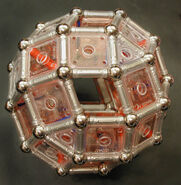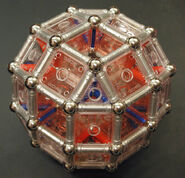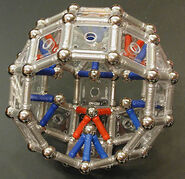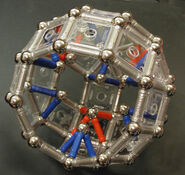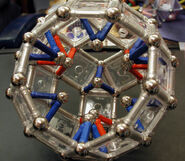| Prism-Expanded Dissected Cuboctahedron | |
 Prism-Expanded Dissected Cuboctahedron | |
| Type | Stewart Toroid |
| Panels | 8 × 78 × |
| Rods | 168 × |
| Spheres | 62 × |
| Author | PolyClare 13:46, 6 February 2008 (UTC) |
The Prism-Expanded Dissected Cuboctahedron is a Stewart Toroid that has a convex hull, but not all faces of that hull are regular.
This particular toroid was discovered by Alex Doskey, which he named the Prism-Expanded Dissected Cuboctahedron. He explains the process used to create this polyhedron (and other "Doskey Toroids") on his Prism Expansions page. The name is derived by starting with a "dissected cuboctahedron", which is the cuboctahedron dissected into 6 square-based pyramids and 8 triangle-based pyramids (tetrahedra). Alex Doskey notates this dissection as B4 ≈ 6Y4 ⊕ 8Y3. The pyramids from the dissection are then separated from each other by one unit length, then a triangular prism is inserted between each pair corresponding faces (for a total of 24 prisms inserted).
For another description of this dissection, see Jim McNeill's Dissection of the Expanded Rhombic Dodecahedron page.
So, to summarize, this object may be composed entirely from:
- 6 square-based pyramids -- one for every square in a cuboctahedron
- 8 triange-based pyramids (tetrahedra) -- one for every triangle in a cuboctahedron
- 24 triangular prisms -- one for every edge in a cuboctahedron (or equivalently, for every edge in its dual, the rhombic dodecahedron, whichever way you want to think about it)
One can view a mathematical construction of this object by starting with the skeleton of a rhombic dodecahedron (just the edges, not the entire solid). For every edge in that skeleton, attach the square:square edge of a triangular prism, with the prism aligned away from the skeleton. Then fill in the spaces between those prisms wtih square-based pyramids or triangle-based pyramids (tetrahedra) as appropriate. There it is!
Using this composition, the numbers of rods, spheres, and panels may be quickly totalled:
- 6 square-based pyramids: 4 red rods, 4 silver rods, 1 clear square, 5 spheres
- 8 triangle-based pyramids: 3 blue rods, 3 silver rods, 1 clear triangle, 4 spheres
- 24 triangular prisms: 3 rods, 3 squares (2 pink, 1 clear), (end triangles with spheres already counted)
6( 8 rods + 1 square + 5 spheres ) + 8( 6 rods + 1 triangle + 4 spheres ) + 24( 3 rods + 3 squares ) -------------------------------------------------------------- = 48+48+72 rods + 6+72 squares + 8 triangles + 30+32 spheres = 168 rods + 78 squares + 8 triangles + 62 spheres
Equivalently, the object may be considered as:
- An Expanded Rhombic Dodecahedron
- Minus 12 rhombic prism holes, in which the ratio of the diagonals of each rhombus is .
- Minus 1 central rhombic dodecahedron hole
NOTE: Interestingly, this model is one way to use Geomags to exactly construct a model that features the usually unattainable rhombi. Of course those rhombi are present only as holes, but they're exact nonetheless.
Other Views[]
Three views of the Prism-Expanded Dissected Cuboctahedron:
Below are images showing the (unfinished) shell of the Expanded Rhombic Dodecahedron, with added (red) square-based pyramids and (blue) triangular-based pyramids / tetrahedra. The innermost vertices of the pyramids will later be connected to form a Rhombic Dodecahedron.
There are multiple construction methods one can employ to build this fabulous toroid. I leave the possibilities up to anyone who wants to build their own model. Below are images of a roughly half-completed model, showing the internal structure of the toroid. I used silver rods and clear panels for the exterior convex hull of the model, red rods for the internal edges of the square-based prisms, blue rods for the internal edges of the triange-based prisms, and off-pale-green (glow-in-the-dark) rods for the edges of the rhombic dodecahedron central hole.
Try wall-eyed stereo (not cross-eyed) with the first two images below (although they both may also be viewed individually at higher resolution).
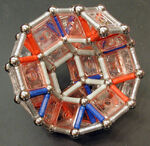
Another View


